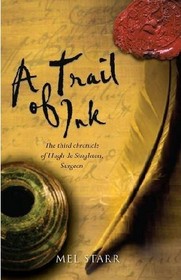Helpful Score: 1
We will never know what it was truly like to live in medieval England: this might just be close as we can get. It's a time when educated men are few and a book is worth such a fortune to a poor man that he risks theft. Language and descriptions work so well, that when the tale erupts, you are there with Hugh de Singleton, surgeon and bailiff, using wits and logic. I loved the archaic words, characters and scenes from many different layers of society - and the juicy descriptions of medieval food. Thankfully there are no explanatory asides to mar the experience; but there is a lexicon: "... a woman dressed in a long cotehardie of blue, and a man wearing parti-colored chauces, a red cotehardie, and a cap ending in a long yellow liripipe." Read on.
This is the Third Chronicle of Hugh de Singleton, Surgeon.
Here is my assessment of the series so far:
The mystery in the first book was incredibly simple and lacked any real depth.
The mystery in the second book was ridiculously complicated, as if it was trying to makeup for the shortcomings of its predecessor.
The mystery in the third book finally struck a good balance between the previous two. However, the overall result was still a plot that ran a little flat.
This book still contains those various odds and ends that make the story seem more artificial than authentic. Starr's continual use of period terms (refer to the glossary in the front of the book for examples) often seem to fall awkwardly in a sentence (ex: "His nose was straight buy mine tends to drift towards the dexter side.") And there were many other times when I wished that Starr would just invest in a thesaurus, as nearly every reference to Kate described her as a "comely lass." Starr is obviously an expert in his field from a historical sense, but that doesn't mean that his knowledge translates well into historical fiction.
In all, I would say that this series is improving. The book is not bad, but it by no means stellar. "Quaint" is a word that comes to mind. The mystery is average, the plot was moderately compelling, and I really have very little idea at all what the characters actually look like (but can tell you in great detail everything that they ate at every remove). Starr is gradually finding his footing as a author. He just has a long way to go before he can truly compete with the heavier hitters in the historical fiction genre.
Here is my assessment of the series so far:
The mystery in the first book was incredibly simple and lacked any real depth.
The mystery in the second book was ridiculously complicated, as if it was trying to makeup for the shortcomings of its predecessor.
The mystery in the third book finally struck a good balance between the previous two. However, the overall result was still a plot that ran a little flat.
This book still contains those various odds and ends that make the story seem more artificial than authentic. Starr's continual use of period terms (refer to the glossary in the front of the book for examples) often seem to fall awkwardly in a sentence (ex: "His nose was straight buy mine tends to drift towards the dexter side.") And there were many other times when I wished that Starr would just invest in a thesaurus, as nearly every reference to Kate described her as a "comely lass." Starr is obviously an expert in his field from a historical sense, but that doesn't mean that his knowledge translates well into historical fiction.
In all, I would say that this series is improving. The book is not bad, but it by no means stellar. "Quaint" is a word that comes to mind. The mystery is average, the plot was moderately compelling, and I really have very little idea at all what the characters actually look like (but can tell you in great detail everything that they ate at every remove). Starr is gradually finding his footing as a author. He just has a long way to go before he can truly compete with the heavier hitters in the historical fiction genre.
Anohter excellent book in the series. More of this book was set in Oxford very interesting setting of the time. Love the romance too. Now I need book 4.
Missing books and the murder of a poor young scholar take Hugh de Singleton from his personal search for a wife. He is attracted to the lovely Katherine Caxton but so is someone else who resents Hugh's courting to the point of framing him for theft, a hanging offense; kidnapping; and possibly murder. Meanwhile, he investigates the theft and discovers the body of a scholar who is believed to have drowned. Hugh's examination shows that isn't so. Is the same person responsible for the theft? Hugh doesn't know but works hard to unravel the mystery.
In the process, his personal troubles interfere with and slow the investigation.
Starr does a remarkable job of placing this mystery in the medieval era. Detail and individual actions seem consistent with what must occur during these events. I liked it and found the author's writing a joy. If you like medieval mysteries, this is one you can put on your reading list.
In the process, his personal troubles interfere with and slow the investigation.
Starr does a remarkable job of placing this mystery in the medieval era. Detail and individual actions seem consistent with what must occur during these events. I liked it and found the author's writing a joy. If you like medieval mysteries, this is one you can put on your reading list.




